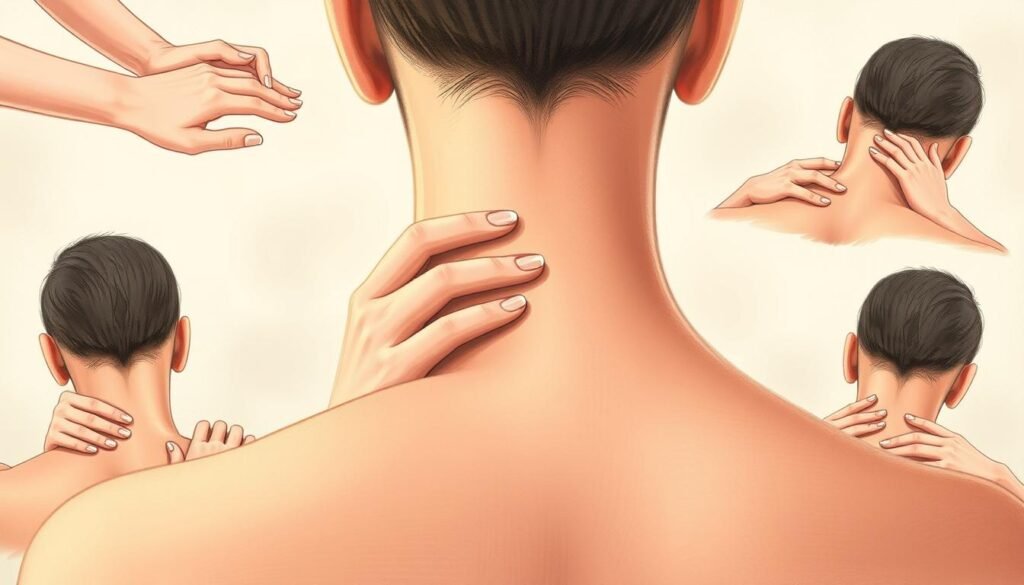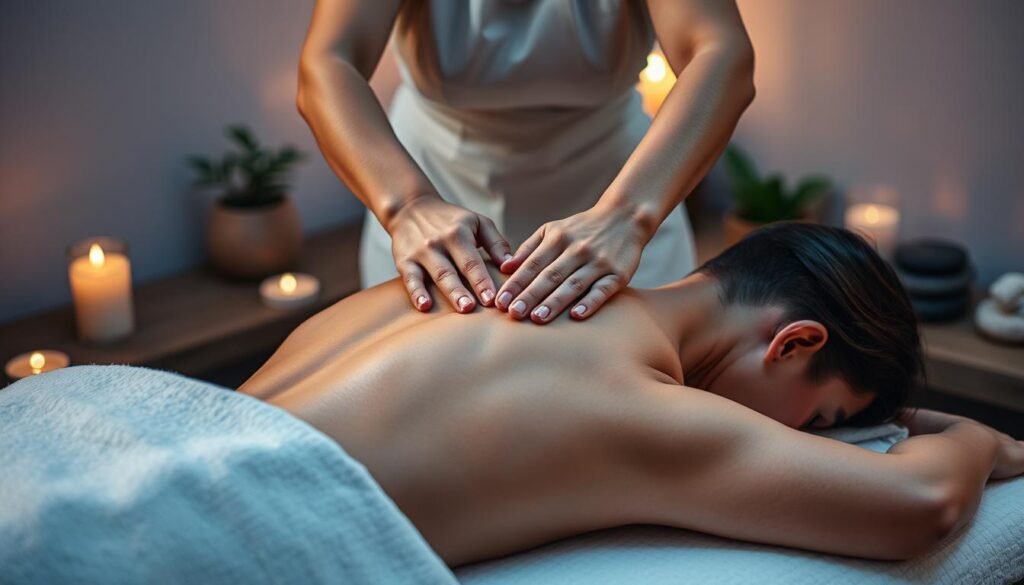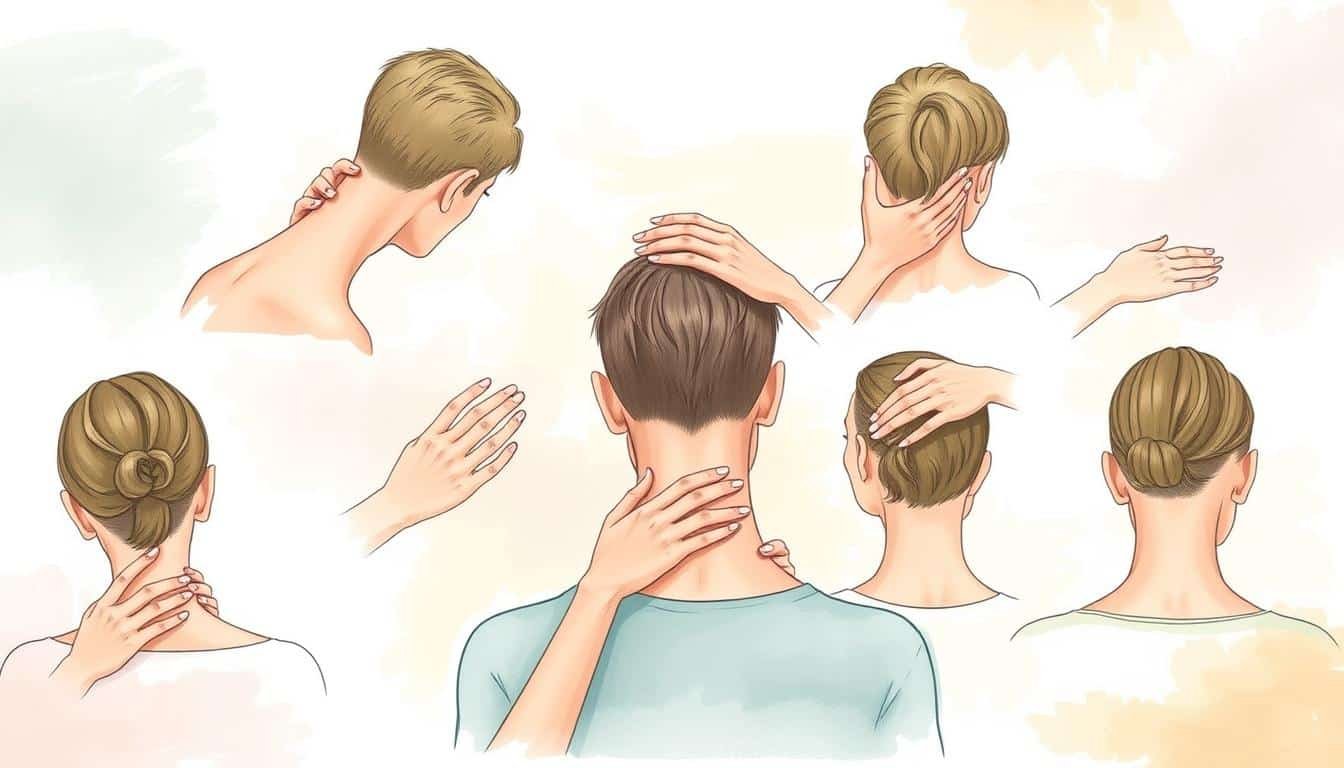Ever wondered why a simple neck rub feels amazing after a long day? Massage is magic because it eases tension and boosts movement. I’m here to teach you how to do neck and shoulder massages, making your daily life better.
In this guide, I’ll show you neck and shoulder massage techniques. You’ll learn to massage your neck and shoulders well, bringing relief and calm. These methods are great for easing tension or enjoying self-care, helping you take care of yourself.
We’ll cover everything from soft strokes to specific pressure points. This is for both beginners and those who’ve done massages before. Get ready to see how touch can change your day and learn to massage at home.
Key Takeaways
- Learn effective neck massage techniques for tension relief
- Discover various shoulder massage methods to improve mobility
- Understand the importance of proper positioning during massage
- Explore the benefits of incorporating massage into your daily routine
- Learn how to create a comfortable environment for optimal massage experience
- Gain insights on using different pressure levels for various massage techniques
Understanding the Importance of Neck and Shoulder Massage
Neck and shoulder massages are key to our well-being. They help a lot with neck tension and shoulder pain. Let’s look at the benefits, why we get tension, and how massages help us move better.
Benefits of Regular Neck and Shoulder Massages
Regular massages bring many good things for our neck and shoulders:
- Stress reduction
- Pain relief
- Improved circulation
- Enhanced flexibility
- Better sleep quality
Common Causes of Neck and Shoulder Tension
Knowing what causes tension helps us fix it:
| Cause | Impact |
|---|---|
| Poor posture | Muscle strain and imbalance |
| Prolonged computer use | Repetitive stress injuries |
| Stress | Muscle tightness and tension |
| Lack of exercise | Weak and inflexible muscles |
How Massage Can Alleviate Pain and Improve Mobility
Massages are great for neck and shoulder problems. They make tight muscles relax, improve blood flow, and help us relax. By focusing on certain spots, massages can lessen shoulder pain and boost movement. Regular massages can keep your upper body pain-free and flexible for a long time.
“A good massage is worth a thousand words – it speaks directly to your body.”
Preparing for Your Neck and Shoulder Massage
Getting ready for a neck and shoulder massage is all about preparation. I’ll show you how to set up the perfect space and gather the right supplies for a relaxing time.
Creating a Comfortable Environment
A calm atmosphere is essential for a great massage. I dim the lights, play soft music, and adjust the room’s temperature. Having a comfy massage table or chair is also important for relaxation.
Gathering Necessary Supplies
I always have these supplies ready:
- Massage oil (coconut, olive, or almond)
- Clean towels
- Pillows for support
- Warm blanket
Quality oils help reduce friction and moisturize the skin. I also keep extra towels for comfort and cleanliness.
Proper Positioning for Optimal Experience
Getting the right position is crucial for a good massage. For seated massages, I make sure the back is straight and shoulders are relaxed. For lying down, a slightly inclined position is best.
I use pillows to support the neck and knees. This helps keep everyone comfortable during the massage.
With these steps, you’re all set for a refreshing neck and shoulder massage.
Basic Techniques for Neck Massage

Learning neck massage techniques can ease neck tension. I’ll show you simple yet effective ways to relax and reduce discomfort.
Begin with soft strokes to warm the muscles. Use your fingertips to make small circles along the neck, slowly adding more pressure. This method loosens tight spots and boosts blood flow.
Then, use your thumbs for firm circular motions. Target areas with knots or tension. This is great for releasing tight muscles.
Next, slide your fingers up and down the neck. Make sure to cover both sides and the back. This stretches the muscles and promotes relaxation.
For specific pressure, pinch along the neck’s back. Use your thumb and index finger to gently squeeze, moving from the skull to the shoulders.
| Technique | Description | Benefits |
|---|---|---|
| Gentle Strokes | Light, long strokes along the neck | Warms up muscles, increases circulation |
| Circular Fingertip Massage | Small circles with fingertips | Loosens tight areas, improves blood flow |
| Thumb Pressure | Firm circular motions with thumbs | Releases tension knots, reduces stiffness |
| Gliding Technique | Fingers gliding up and down the neck | Stretches muscles, promotes relaxation |
| Pinching Method | Gentle squeezing along the back of the neck | Provides targeted pressure, relieves tension |
Start with gentle pressure and increase as needed. Regular use of these techniques can greatly reduce neck tension.
Essential Shoulder Massage Methods
Shoulder massage methods can really help with tension and relaxation. I’ll share some effective techniques to ease tight muscles and knots.
Kneading Techniques for Shoulder Muscles
Kneading is crucial for loosening shoulder muscles. I start with my thumbs in small, circular motions. This breaks up knots and boosts blood flow. For bigger areas, I use my palm’s heel for broad, sweeping motions.
Circular Motions to Release Tension
Circular motions are excellent for releasing tension. I use my fingertips to make small circles around the shoulder blades and upper arms. This warms up the muscles for deeper work.
Pressure Point Therapy for Shoulders
Pressure point therapy targets specific areas. I focus on spots around the shoulder blades and under the collarbone. Applying firm, steady pressure for 10-15 seconds can ease pain and tension.
| Massage Method | Technique | Benefits |
|---|---|---|
| Kneading | Circular thumb pressure, palm heel strokes | Breaks up knots, improves circulation |
| Circular Motions | Small circles with fingertips | Warms up muscles, releases tension |
| Pressure Point Therapy | Firm, steady pressure on specific points | Targets pain, relieves tension |
By mixing these shoulder massage methods and kneading techniques, you can create a full routine. This routine helps with shoulder discomfort and promotes relaxation.
How to Massage a Neck and Shoulders: Step-by-Step Guide

I’m excited to share this step-by-step massage guide for neck and shoulder techniques. Let’s dive into the process of giving a relaxing and effective massage.
Start with gentle warm-up strokes across the shoulders and neck. This preps the muscles for deeper work. Next, use your thumbs to knead the shoulder muscles in circular motions. Move to the neck, applying gliding strokes from the base of the skull down to the shoulders.
For the shoulder blades, use your fingertips to make small circles. Don’t forget the upper arms and area under the collarbones – these often hold tension too. Vary your techniques to keep the massage engaging and effective.
- Warm-up strokes
- Shoulder kneading
- Neck gliding
- Shoulder blade circles
- Upper arm and collarbone work
Use different parts of your hands for varying pressure levels. Palms work well for broad strokes, while fingertips are great for targeted pressure. Remember to check in with the person receiving the massage to ensure comfort throughout.
| Technique | Area | Pressure |
|---|---|---|
| Kneading | Shoulders | Medium |
| Gliding | Neck | Light to Medium |
| Circular Motions | Shoulder Blades | Medium to Firm |
By following this neck and shoulder massage techniques guide, you’ll be able to provide a soothing and effective massage experience. Remember to stay attentive to the recipient’s comfort and adjust your techniques as needed.
Incorporating Deep Tissue Massage Techniques

Deep tissue massage is a step up from regular neck and shoulder work. I’ll show you how to tackle tough knots and tension with advanced techniques.
Identifying and Targeting Muscle Knots
Muscle knots feel like small, hard lumps under the skin. To find them, I gently press my fingers along the neck and shoulders. Once I locate them, I apply firm, circular pressure with my thumb or knuckles to start the removal process.
Using Appropriate Pressure for Deep Tissue Work
Deep tissue massage needs more force than regular massage. I start with moderate pressure and then increase it. It’s important to go slow and steady, letting the muscles relax and accept deeper pressure over time.
Precautions When Performing Deep Tissue Massage
Safety is key during deep tissue work. I avoid applying direct pressure on bones, joints, or the spine. If the recipient feels sharp pain or discomfort, I immediately reduce pressure or stop. It’s crucial to communicate constantly and adjust techniques as needed.
| Deep Tissue Massage Technique | Benefits | Precautions |
|---|---|---|
| Stripping | Releases muscle adhesions | Avoid on bony areas |
| Friction | Breaks down scar tissue | Use caution on inflamed areas |
| Trigger Point Therapy | Relieves referred pain | Limit duration to prevent bruising |
Self-Massage Techniques for Neck and Shoulders
I’ve found that self-massage techniques are a big help for neck and shoulder care. They let me handle tension and pain between professional massages. Here are some easy methods to try at home.
For my neck, I use my fingertips in gentle circular motions. I start at the base of my skull and move down to my shoulders. This eases tension and boosts blood flow.
For my shoulders, I use my opposite hand to knead them. I focus on tight or sore spots, adjusting pressure to release knots.
Tools can make self-massage better. A tennis ball or foam roller can reach hard spots. I roll these tools on my shoulders and upper back, stopping on sensitive areas for more relief.
| Area | Technique | Duration |
|---|---|---|
| Neck | Circular fingertip motions | 2-3 minutes |
| Shoulders | Cross-body kneading | 3-5 minutes per side |
| Upper back | Tennis ball rolling | 5-10 minutes |
Adding these self-massage techniques to my daily routine has greatly improved my neck and shoulder comfort. Always be gentle and listen to your body during self-massage.
Using Tools and Aids for Enhanced Massage
Massage tools can really boost your neck and shoulder relaxation. They help reach and relieve hard spots. Let’s look at some great options.
Tennis Ball Massage for Tricky Spots
Tennis ball massage is amazing for those tough knots. I put a tennis ball against my back and a wall. Then, I roll it to find tight spots. It’s great for areas my hands can’t reach.
Foam Roller Techniques for Shoulders
Foam rollers are perfect for the shoulders. I lie on a foam roller, which is against my spine. Slowly rolling back and forth helps loosen my upper back and shoulders.
Handheld Devices for Targeted Relief
Handheld massage devices give you control over pressure. I use them on my neck and shoulders to tackle tough knots. Some models even have vibration and heat for extra comfort.
| Tool | Best For | Ease of Use |
|---|---|---|
| Tennis Ball | Specific muscle knots | Easy |
| Foam Roller | Large muscle groups | Moderate |
| Handheld Device | Targeted pressure | Easy to Moderate |
Adding these massage tools to your routine can make your self-care better. You’ll get deeper relaxation in your neck and shoulders.
Combining Stretches with Massage for Better Results
Pairing stretches with massage can greatly improve your neck and shoulder care. Adding gentle movements before and after massage boosts results. It prepares your muscles and extends the benefits.
Start with pre-massage neck stretches to loosen tight muscles. Try slow neck rolls and gently tilt your head from side to side. Shoulder stretches like shoulder shrugs and arm circles warm up the area for massage.
After your massage, do light stretching to keep flexibility. This helps keep the relaxation and pain relief from the massage. Move slowly and stop if you feel discomfort.
| Stretch | Area Targeted | Duration |
|---|---|---|
| Neck Rolls | Neck muscles | 30 seconds |
| Shoulder Shrugs | Upper trapezius | 10 repetitions |
| Arm Circles | Shoulder joint | 15 seconds each direction |
Combining stretches with massage is a complete approach to neck and shoulder care. It improves circulation, increases range of motion, and prevents future tension. This is especially important for these often-stressed areas.
Safety Precautions and Contraindications
Massage safety is key when working on the neck and shoulders. I always put my clients first by following strict rules. Knowing what not to do helps avoid harm and makes sure everyone has a good time.
When to Avoid Neck and Shoulder Massage
There are times when massage can actually hurt. I never massage areas with open wounds, recent injuries, or skin infections. It’s best to wait until these heal before applying pressure.
Signs to Stop the Massage Immediately
I’m always watching for signs of discomfort during a massage. If a client feels more pain, numbness, or tingling, I stop right away. These could mean nerve problems or other serious issues.
| Warning Sign | Possible Cause | Action |
|---|---|---|
| Sharp Pain | Nerve Compression | Stop and Reassess |
| Numbness | Circulation Issues | Cease Massage |
| Tingling | Nerve Irritation | Discontinue Session |
Consulting a Professional for Chronic Pain
For those with chronic pain or medical conditions, I suggest talking to a doctor before getting a massage. This step makes sure massage is safe and right for them.
Remember, safety first when it comes to massage. Knowing what not to do and being careful during sessions means I can give my clients a safe and helpful massage.
Incorporating Aromatherapy and Essential Oils
I love adding aromatherapy to my neck and shoulder massages. Essential oils make the experience even better. Lavender oil is my favorite for relaxation. Its calming scent helps me relax after a long day.
For pain relief, I choose peppermint oil. Its cool touch quickly eases muscle tension. Eucalyptus oil is great for reducing inflammation. Always mix these oils with a carrier oil like jojoba or almond oil before applying to your skin.
Before trying new oils, I do a small patch test. This helps me avoid any allergic reactions. If you’re pregnant or have sensitive skin, it’s wise to consult a doctor first. With the right precautions, aromatherapy can greatly improve your physical and mental health.
FAQ
What are the benefits of regular neck and shoulder massages?
What are some common causes of neck and shoulder tension?
How should I prepare for a neck and shoulder massage?
What are some basic techniques for neck massage?
How can I effectively massage the shoulders?
Can you provide a step-by-step guide for massaging the neck and shoulders?
How can I incorporate deep tissue massage techniques?
What are some self-massage techniques for the neck and shoulders?
How can I use tools and aids for an enhanced massage?
Should I incorporate stretches with massage for better results?
Are there any safety precautions or contraindications for neck and shoulder massage?
Can I incorporate aromatherapy and essential oils into my massage?
Source Links
- Shoulder and Neck Massage – https://myhealth.alberta.ca/Health/pages/conditions.aspx?hwid=ta4743&lang=en-ca
- Massage Techniques to Give Yourself Some Love – https://www.healthline.com/health/self-massage
- How to Give a Neck Massage (with Pictures) – wikiHow – https://www.wikihow.com/Give-a-Neck-Massage













10 Comments
Does anyone else wonder if regular neck and shoulder massages could potentially weaken our muscles over time? Just a random thought.
Is anyone else skeptical about DIY massages? I mean, can they really be as effective as professional ones?
Interesting read, but does regular neck and shoulder massage really improve sleep quality as some claim? Would love to see research on that!
Does anyone else find neck and shoulder massages more effective when done by professionals rather than DIY methods? Just a thought!
Interesting article! But arent there any potential risks or side effects of regular neck and shoulder massages we should be aware of?
Interesting read! But dont you think a focus on self-massage techniques could have added more value to this article?
Definitely not! The articles focus was perfect. Self-massage isnt a fit-all solution.
Interesting read, but do we consider the risks of incorrect massage techniques? Could they potentially worsen the tension?
Does anyone else think neck massages could potentially worsen certain existing neck conditions instead of relieving tension?
Interesting read! But, wouldnt it be better to include a section on self-massage techniques for those living alone?